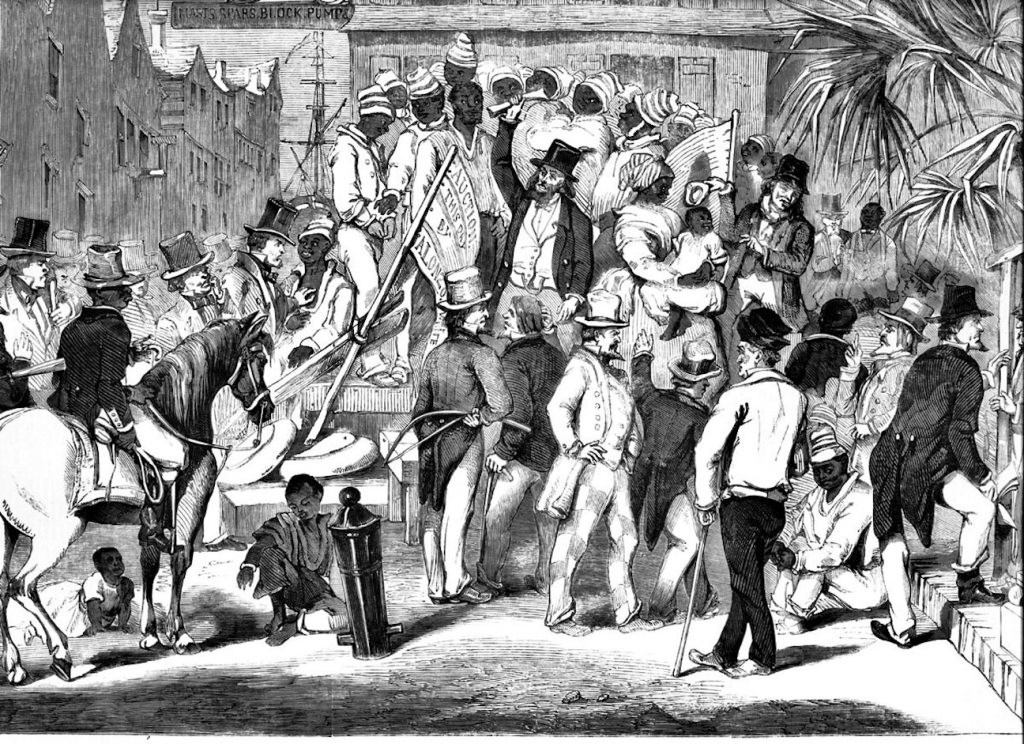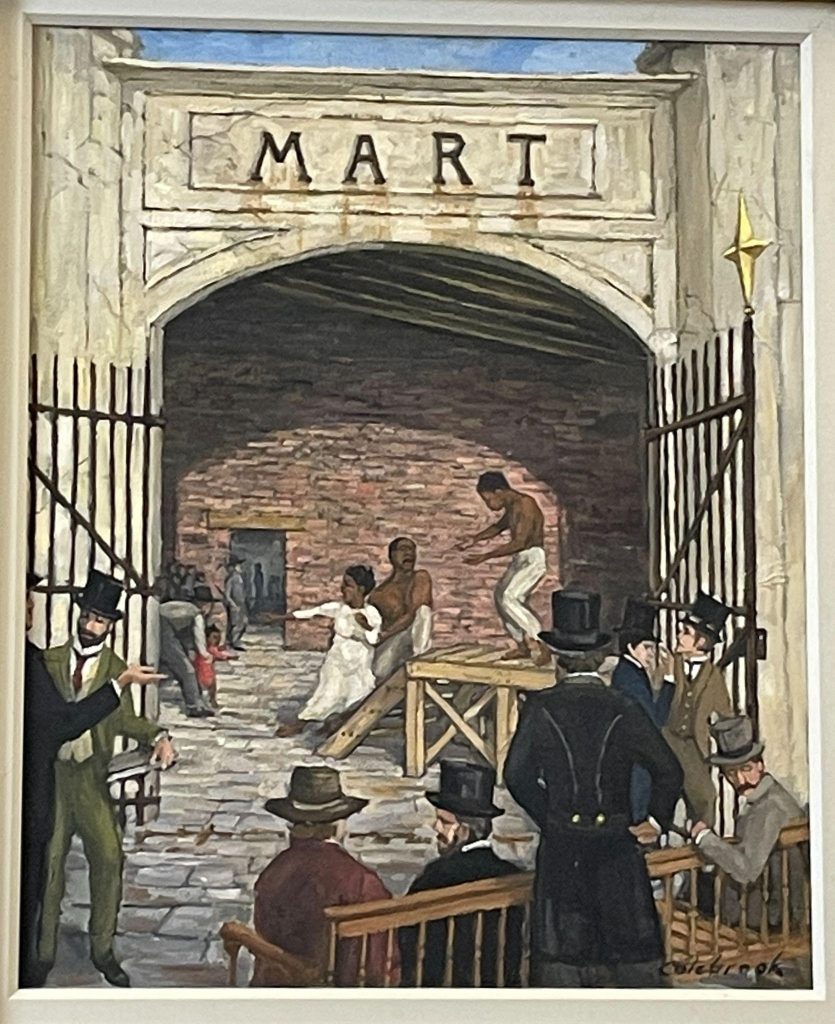» Part 1: Old Slave Mart and Charleston’s Historic Memory by Mateo Mérida
For the many travelers from around the world who visit Charleston, part of their journey is driven by a want to develop a better individual understanding of the history of slavery. With maybe as many as 40% of all enslaved people imported into the United States coming through Charleston, slavery is inherent to the historical narrative of Charleston.1 To help accommodate that curiosity, the Old Slave Mart Museum has operated to create an honest, but approachable understanding of slavery to the public. While the museum is a highlight for many today because of its direct confrontation with the realities of slavery, this is not a development that happened easily. Instead, the very site itself is a physical manifestation of how the popular understanding of slavery has changed and evolved across the city’s history. The broad history of 6 Chalmers street provides a powerful case study of the evolution of the popular understanding of slavery in Charleston, as the site has adapted to the changing times from the antebellum period well into the current day.
There are three distinctive periods of 6 Chalmers Street: as an auctioning site of enslaved people, as a private museum in the mid-1900s, and finally as a city museum from 2007 to today. To approach each of these, this study will be broken into three pieces, focusing on each respective period.

In the beginning of the first period, Ryan was a member of the Charleston City Council in 1856. In his time, street auctions were highly public spectacles in Charleston, were vociferous auctioneers sold horses, carriages, and slaves. Business for the auctioneer meant breaking up families, while interested onlookers, most of whom did not have the means to participate in the auctions, watched for their own entertainment. These auctions would amass massive crowds, which made navigating the streets of Charleston a logistical nightmare. Additionally, as entrepreneurs, investors, and other business associates traveled to Charleston from Northern cities like Boston, Philadelphia and New York, the city began to develop a negative reputation for practicing the slave trade in such plain site.2
The city needed to directly react to the perception of slavery from Northerners. Thanks to significant events such as the caning Charles Sumner by Preston Brooks in 1856, following after the outbreak of violence in Kansas in 1854 surrounding if it was to become a slave-state, tensions across the United States were climbing quickly relating to slavery. To avoid the potential loss of business from Northern partners, and address the traffic related logistical problems of outdoor slave auctions, Thomas Ryan and the rest of the city council passed a city ordinance that required these auctions to move into private settings. In no way was the ordinance holistic, as it created the means for the city to continue to profit from the auctions of goods and enslaved people while sustaining business beyond the South.3
Ryan also saw this city ordinance as an opportunity. As he prepared for the city ordinance to be enacted, he purchased a lot of land on 6 Chalmers street—out of sight of Charleston’s busiest roads, but still smack in the middle of Charleston’s business district—calling it Ryan’s Mart. Ryan’s Mart was one of at least 40 different slave auctioning sites in the lower portion of the Charleston peninsula.4 These other sites—which were law firms, private businesses, and homes—saw smaller sales between individuals, however, Ryan’s Mart was distinguished as a whole sale auctioning site. The establishment was extensive. While the address was listed as Chalmers street, the entire property stretched into the next block on Queen Street, and included four total structures. The “structure” immediately on Chalmers street was the auctioning space, which bore no ceiling overhead, utilized the wall of the firehouse next door, with a wooden façade serving as the gate to the property. Beyond the auctioning room were three other buildings, which included a cookhouse, a “dead house” or morgue, and a four story barracoon, which could house dozens of enslaved people prior to auction. With the exception of the auctioning room, each of those buildings are gone today. Conservatively, as many as 10,000 enslaved people were auctioned from Ryan’s Mart, and dispersed as far West as Texas.5
Slavery for Thomas Ryan (and Ziba B. Oakes, who would purchase the property from Ryan in 1859) was a business opportunity. For each auction that took place on 6 Chalmers street, Ryan received a percentage of the profits of the auction to compliment his salary as city councilor. Slavery was the foundation of the entire economy of Charleston, and of the entire plantation economy of South Carolina. Ryan benefited from slavery indirectly as a city councilor, as the taxes earned from plantations and enslavers funded his salary, yet 6 Chalmers street didn’t merely enable slavery, but made him the direct beneficiary of its proliferation. Despite the changing tide as to how slavery was understood by the states who became the Union, it was not just the reality of the South, but a net good for white elites like Ryan.

Despite how slavery was viewed by elite Southerners in Ryan’s time, 6 Chalmers street as an auctioning site would be forced to shut its doors after only seven years of operation. As a direct result of the Union Navy’s bombardment of Charleston during the Civil War, Ryan’s Mart was only operational for seven years. Once the war was over, however, the people who once would have been housed in the barracoon now called it a home. The buildings of Ryan’s Mart served as a tenement home following after the Civil War, as now free Black people sought work in whatever manner they could find. Around the turn of the century, the space that was once the auctioning site would become an auto-repair shop.6
While the Civil War would force the auction site to close, it also forced Charleston to reconsider how it understood the slavery, and make choices regarding how it remembered it.
Be sure to check back next week for part two, where we will learn about how 6 Chalmers functioned as a museum.
Sources
- Battle, Mary. “Africans in Carolina.” African Passages, Lowcountry Adaptations. Lowcountry Digital History Initiative: Charleston, South Carolina. 2013. Accessed Dec. 8, 2022.
- Butler, Nic. “Street Auctions and Slave Marts in Antebellum Charleston.” Charleston Time Machine. No. 187. Charleston County Library: Charleston, SC. Jan. 22, 2021. Accessed Dec. 1, 2022.
- Ibid.
- Bancroft, Frederic. Slave Trading in the Old South. University of South Carolina Press: Columbia, SC. 1996. Pp. 175-177.
- Yuhl, Stephanie E. “Hidden in plain sight: centering the domestic slave trade in American public history.” Journal of Southern History. Vol. 79, 3. pp 599.
- Drago, Edmund L., and Ralph Melnick. “The Old Slave Mart Museum, Charleston, South Carolina: Rediscovering the Past.” Civil War History. Vol. 27, No. 2. June 1981. pp 153.
Image Credits
- Butler, Nic. “Street Auctions and Slave Marts in Antebellum Charleston.” Charleston Time Machine. No. 187. Charleston County Library: Charleston, SC. Jan. 22, 2021. Accessed Dec. 1, 2022. https://www.ccpl.org/charleston-time-machine/street-auctions-and-slave-marts-antebellum-charleston#_edn10.
- Unknown Artist. Unknown Title. Old Slave Mart Museum: Charleston, SC. Unknown creation date. Image taken Dec. 5, 2022.
